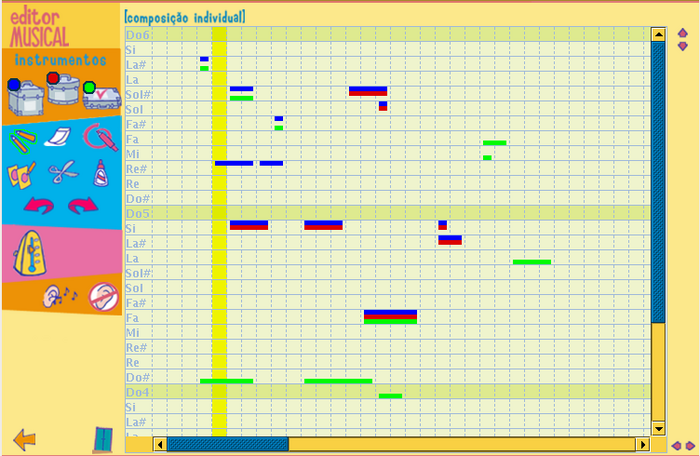Musical Editor: Difference between revisions
Jump to navigation
Jump to search
(→Team) |
|||
| Line 28: | Line 28: | ||
== Team == |
== Team == |
||
*Alexandre Martinazzo<br> |
* [[user:Alexandremartinazzo|Alexandre Martinazzo]]<br> |
||
*Gustavo Rocha Dias<br> |
* Gustavo Rocha Dias<br> |
||
*Hernan Martinez |
* Hernan Martinez<br> |
||
*Joyce Alessandra Saul<br> |
* [[user:Joyce|Joyce Alessandra Saul]]<br> |
||
*Irene Karaguilla Ficheman<br> |
* Irene Karaguilla Ficheman<br> |
||
*Oswaldo Bassani Neto<br> |
* Oswaldo Bassani Neto<br> |
||
*[[user:barbolo|Rafael Barbolo Lopes]]<br> |
* [[user:barbolo|Rafael Barbolo Lopes]]<br> |
||
*Roseli de Deus Lopes |
* Roseli de Deus Lopes<br> |
||
== Related Links == |
== Related Links == |
||
Revision as of 23:52, 25 August 2006
The Application
The Musical Editor is a musical software that allows children to learn how to develop their own compositions.
It has been developed by LSI (Integrated Systems Laboratory)
LSI is a Brazilian institution that has developed applications to support Education and has created some teams to work on OLPC software development.
These teams are rewriting some Java applications in Python.
One of this softwares is the Musical Editor.
Features
- Easy to use
- No limitation on instruments quantity
- Currently, the composition mode is unique (Grid Mode), however it's probable that new modes integrate the software
- Each instrument belongs to a group (for example, the group of string instruments), each group has a especific color.
Thus, the user can assimilate the color to the group of instrument and will notice that each group has a role in music.
- The application runs in monouser or colaborative mode (mesh network)
- We will try to implement a way of recording sonds from the internal microphone of OLPC
Team
- Alexandre Martinazzo
- Gustavo Rocha Dias
- Hernan Martinez
- Joyce Alessandra Saul
- Irene Karaguilla Ficheman
- Oswaldo Bassani Neto
- Rafael Barbolo Lopes
- Roseli de Deus Lopes
Related Links
- Editor Musical -- Portuguese version
